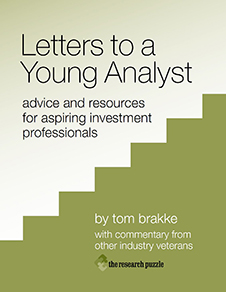
- Monday, December 14th, 2009
- loose ends
-
And so we come to the end of my series on the Global Research Analyst Settlement.the research puzzle | Here’s the entire series of postings. Fittingly (since we all like round numbers so much), this is also posting number one hundred of these little essays since I started blogging. I guess it’s time to pull together some of the loose ends.
As I have indicated in previous postings, October 31 marked the end of my involvement in the settlement. That meant wading through the paper files that piled up from research firms, the performance evaluation service that I used, and that I produced myself — and sending them off for archival storage, probably never to be read again. In addition, there were more than fifty gigabytes of electronic information (including over seventeen thousand emails and Excel spreadsheets of all manner and complexity) copied onto a drive for posterity.
While my documents have been put to rest, there are some loose ends for the settlement. Two investment banks settled later than the original ten, so the independent research will flow there for a little while longer. And I believe that all of the banks are awaiting further rulings from the court on a number of operational issues, including leveling the playing field versus other firms in cases where the settlement posed additional burdens. (Post-settlement, if the rules make sense they should apply to all; if they don’t, they should apply to none.)
Many of the issues that drove the settlement have not gone away, not the least of which is the advantage that accrues to brokerage firms from bundling their research with other services in ways that other research providers cannot.Financial Times | This is a recent FT article on the aftermath of the settlement which addresses that point. I’ve always thought it’d be great if the whole world of research worked off of hard dollars. I think it makes better sense if the consumers of the research pay for it cleanly and directly, leaving out the distortions from bundling, soft dollars, etc., but a debate on the conceptual alternatives and nitty-gritty realities is best left for another day.
As it is, the market for research is alive with change. New firms pop up as others are shuttered. Electronic communities swap ideas of all kinds (that run the gamut from outstanding to awful), and a byproduct is some “Napsterization” of investment research published by leading firms. That should be expected, since it seems to happen to any product delivered electronically these days, but it presents an important issue going forward. In general, while the research business is still too tied to traditional processes and formats for my taste, there are lots of interesting developments around the edges.
The performance pattern of the equity market during the settlement provided an unusual backdrop for the evaluation of research, in that it so clearly was marked by two distinct periods. The first three years it was smooth sailing, with low volatility, and then all hell broke loose. The resulting strains tested the underpinnings of the business itself — where the shock waves will be felt for years — but it was a wonderful laboratory in which to examine the interplay of the market, research firms, and end users.
A former colleague told me when I signed on as a consultant for the settlement, “Take notes. It will make for a fascinating book.” For now, you’ll have to settle (so to speak) for the nine postings I have written. Maybe someday I’ll delve into the details a bit more, but doing the topic justice in longer form would require a thorough investigation that included the perspectives of other consultants, the settling firms, research providers, and regulators, rather than just my own observations and opinions.
For me, a chapter of life has passed. For the business of investments, another episode of cat and mouse with the regulators is just about completed, although the list of them is never ending. There are always loose ends for someone to play with, and stories like this one to be written yet again.
